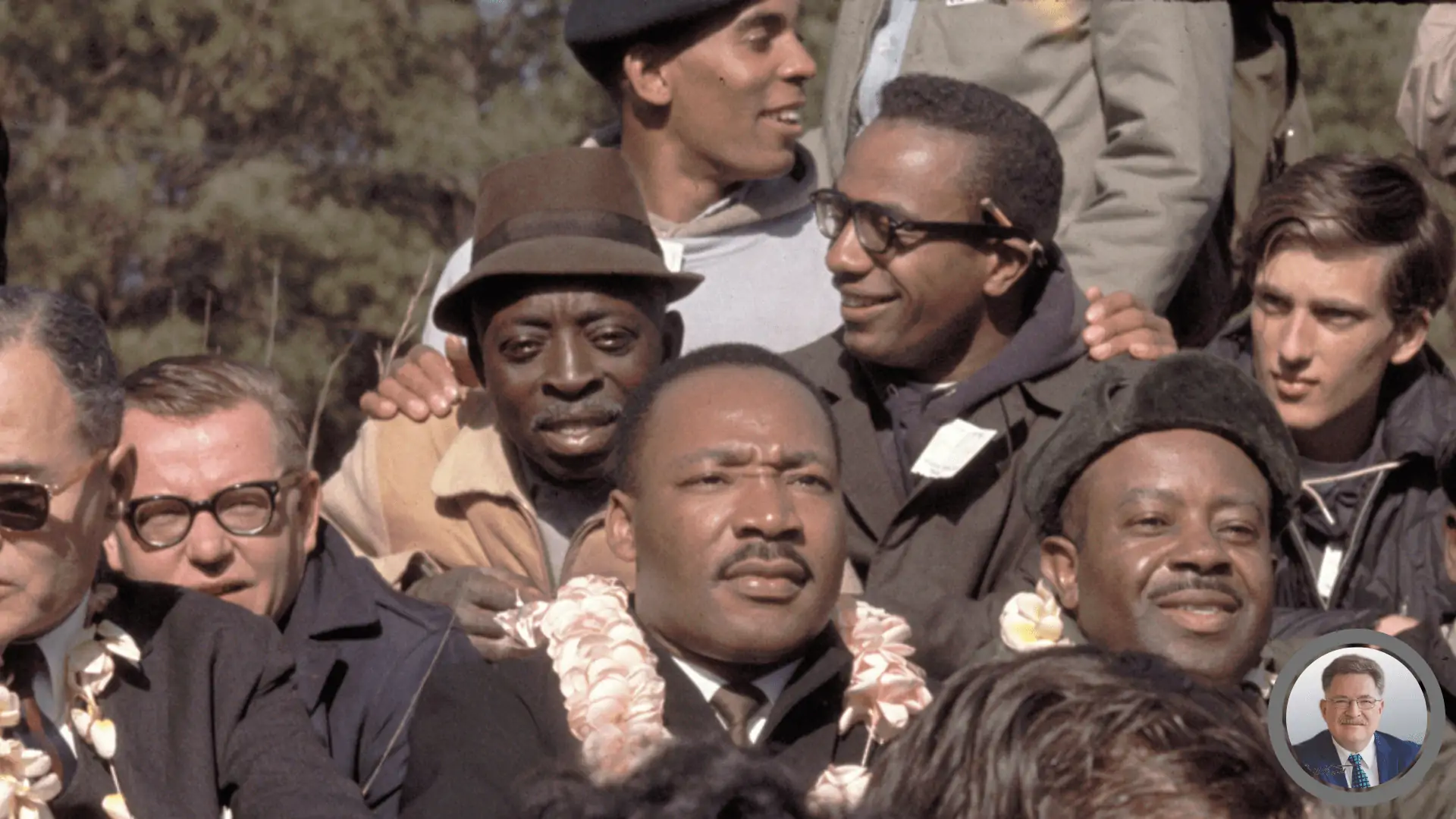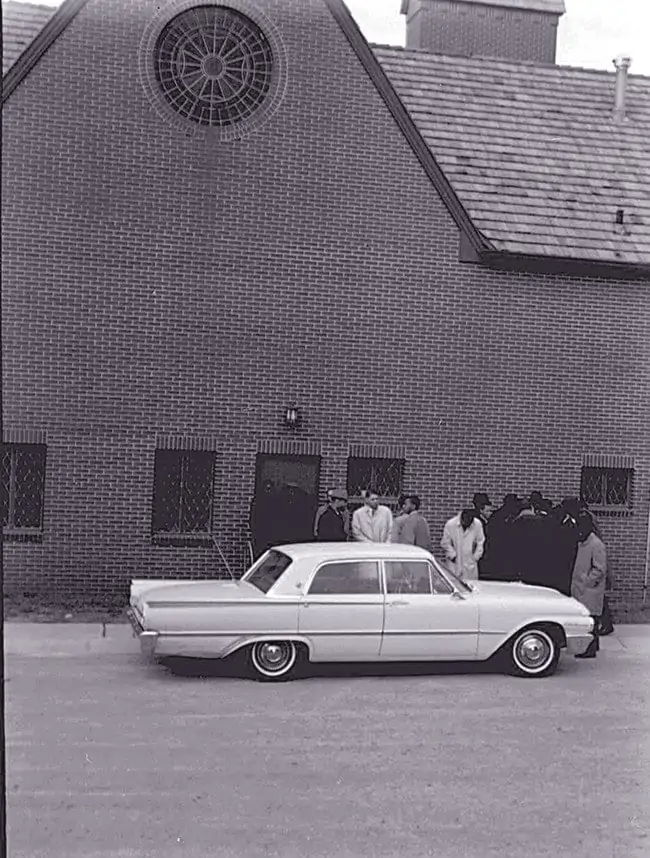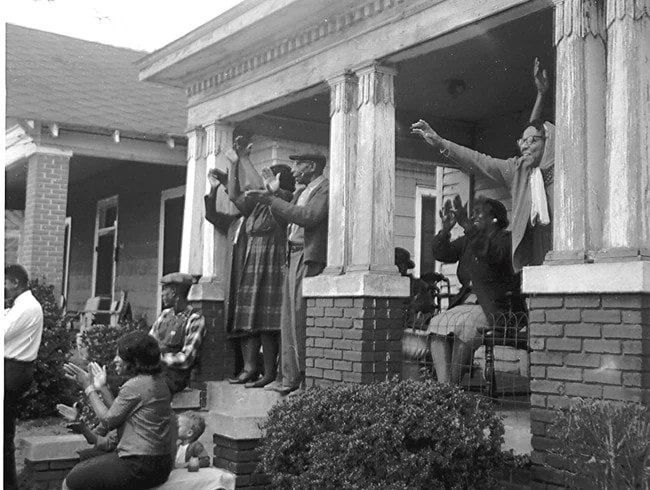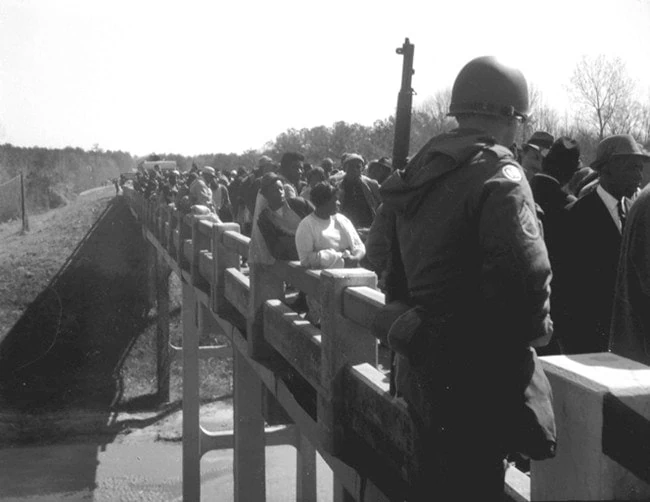
[Editor’s Note: This article was first published on May 26, 2005 in the Adventist Review.]
THE KICKS ON ROUTE 66 WERE FEW, and usually only when the 6' 3" guy wedged into the luggage space of the two-seater Karmann Ghia tried to straighten his legs.
Out through the predawn darkness of the Mojave Desert, past the arid emptiness of Bristol Dry Lake, across the Red Rock Bridge over the Colorado River into the high desert of Arizona the tiny vehicle rolled, filled beyond capacity with men on a mission. Kingman, Flagstaff, Gallup, Albuquerque, Amarillo—the city limits signs blurred along the famed highway called the “Main Street of America,” so celebrated in song and story and film.
It was anything but a pleasure trip. Four young Adventist men—two African-Americans, one Hispanic, one Caucasian—were poured into a space intended for two, one in each seat, one straddling the gear shift console and shifting on command, the fourth wedged in a prenatal crouch in the back where luggage normally was stowed. For 2,300 miles and 44 hours—from Oakland to Selma, Alabama—they endured the least comfortable ride of their lives because they didn't want to miss an event that had “history” and “justice” written all over it.
Into the Furnace
The March 1965 road trip that took Paul Cobb, Will Battles, Fernando Canales, and Milton Hare from the quiet confines of Pacific Union College (PUC) and sedate Bay Area Adventist churches to the dangerous front lines of America’s civil rights movement also put them on a journey that permanently changed their relationships with the denomination in which they had grown up. Each of the four had been educated at Adventist schools—Golden Gate Academy, Mountain View Academy, or PUC—and each had experienced the subtle and not-so-subtle discrimination of local congregations that in 1965 still refused to admit persons of color or made them feel distinctly unwelcome. Even on the college campus, minority students were assigned to menial jobs in the kitchen or barn and were not encouraged to room with or date those outside their racial group.
For 20-year-old Milton Hare, descendant of a long line of White Adventist ministers and educators, the school administration's prohibitions seemed more a challenge than an obstacle. Milton dated a non-White girl for some months, mixed easily with the 100 or so Blacks, Hispanics, and Asians on campus, and helped evade the dormitory rule about same-race roommates by sharing a three-room “apartment” in his wing that welcomed men of all races. The interracial housing arrangement was the brainchild of a vibrant, well-read African-American named Paul Cobb, whose irrepressible good spirits and journalistic skill soon made him a favorite on the campus and a regular sports columnist in the PUC Chronicle.
Cobb’s wide-ranging interests and many ties to the Black community in the Bay Area helped to keep minority students on the PUC campus aware of events then unfolding in the South, and of the efforts of civil rights leaders Hosea Williams, John Lewis, Andrew Young, and Martin Luther King, Jr.
“Paul was intellectually curious at a time when many of the guys in the dorm weren't intellectually oriented,” remembers Fernando Canales, then a sophomore German and chemistry major originally from Nicaragua. “We spent a lot of time in his room talking about books and ideas, current events. Most of our classmates were good, middle-of-the-road kind of folks who didn't involve themselves in social issues. We were clearly thought of as part of the ‘fringe.’”
By the fall of 1964, Milton Hare had experienced his own awakening to broader social issues. Now married and a transfer student at the University of California at Berkeley, Milton was electrified by the burgeoning Free Speech movement then sweeping the Berkeley campus under the leadership of student activist Mario Savio.
“I'd been an Adventist all my life—raised totally Adventist,” Milton recalls, “and I was walking into a situation that was just ripe for me—or I was ripe for it.” Attracted by the students’ demands that the campus be opened to public meetings and untraditional viewpoints, including fund-raising drives for voter registration efforts in the South, Milton found a natural convergence with his Adventist heritage: “I said to myself, ‘That really makes sense. People do have a right to speak, and they have the right to vote. And truth is important.’”
Milton threw himself into a sequence of marches and demonstrations organized by the Free Speech movement, and soon was lining up pro bono lawyers and raising thousands of dollars in bail money for the hundreds of students who were arrested in the university’s crackdown on the protests. As his grades dropped and the Free Speech crisis wound down through the winter of 1964-1965, Milton found himself back in the orbit of his PUC suitemate, Paul Cobb.
“Paul and I were driving in my Karmann Ghia on the interstate, listening to KDIA out of Oakland, and its news reports about the aftermath of the March 7 Selma confrontation where so many marchers were beaten and attacked,” Milton says. “Over the next few days as we heard the news about the death of James Reeb (a White Unitarian minister supporting voting rights for Blacks who died on March 11 after being attacked by Whites on March 9) and about the overall crisis, we said, ‘Let's go. Let’s drive down there to Selma.’”
The Eyes of a Nation
As their plans evolved during the next week, events on the national stage and in Alabama took momentous turns. In the aftermath of the bloody March 7 confrontation between Alabama National Guard troops and 600 marchers led by Hosea Williams and John Lewis at the Edmund Pettus Bridge in Selma, Martin Luther King, Jr., and the Southern Christian Leadership Conference (SCLC) called for a second march two days later while they sought a federal court order that would prevent police from disrupting their march. Denied the restraining order but supported by hundreds of northern ministers, White and Black, King nonetheless stopped the March 9 procession shortly after it started to avoid further bloodshed, calling it a “ceremonial” march.
Faced with a spiraling crisis, six days later, on March 15, U.S. president Lyndon Johnson voiced his support in a televised message for legislation then stalled in Congress that would expand voting rights for Blacks. On March 17, Federal District Court Judge Frank M. Johnson, Jr., ruled in favor of the demonstrators seeking to march from Selma to Montgomery. Alabama National Guard troops were “federalized” and committed to protect the thousands expected to respond to Dr. King's call for a third march on March 21 to the state capitol in Montgomery.
When the third march was announced, the young Adventists had already committed to the trip even though PUC administrators were passing the word that students should not participate in any of the marches.
“I got a call from Paul Cobb about 9:30 or 10:00 one night,” remembers Will Battles, then a 19-year-old graduate of Golden Gate Academy working at a Bay Area post office. “I was already half asleep, and he wanted to know if I had seen the news—if I was aware of what was happening with the march.”
“‘They've sent out a national call to come to the march,’ Paul told me, ‘and we're going to go down to Selma and you are going to drive your brand-new 1965 Mustang.’ That woke me up quickly, you know.”
“I told Paul, ‘I'll consider going down to Selma with you guys, but I'm not thinking about driving my car. Whenever they show news about the marches, they're showing pictures of cars being turned over and burned. I'm parking the Mustang in the garage, but I'll see if I can arrange a leave of absence.’”
Their transportation options dwindling quickly, the four decided to try and squeeze into Milton's two-seater Karmann Ghia for the daunting cross-country trip. With $200, press credentials for the event issued by the friendly publisher of the Oakland Post, and as much film as they could gather, the quartet began driving late in the evening of March 17. Forty-four hours later, including a stop in Amarillo to replace all the tires, they arrived on the campus of Oakwood College in Huntsville, Alabama, where both Paul Cobb and Will Battles had friends.
On the Ground in Alabama
“We just showed up at Oakwood: I don't think anybody knew we were coming,” says Milton. “And I don't think the administrators knew that we were planning to go on the march when they gave permission for us to stay on campus. We found out right away that Oakwood students had been told that they would be disciplined if they joined the march.”
“The students we met at Oakwood were overjoyed that someone who was in their midst was going to the march,” he recalls. “There was this palpable sense of ‘Hallelujah! Someone’s going! Some Adventist is going to march in this thing!’ The guys in the dorm even insisted that we sleep in their beds while they slept on the floor.”

On Sabbath, the four Californians joined a group of Oakwood students and a college theology professor in attempting to worship at the all-White Central church in Huntsville. The church parking lot was jammed with cars, and the atmosphere was tense. When Milton approached the car of some White Adventists to ask what was happening, he was informed that “these Negroes have their own church, but they insist on attending ours.”
“It was all said so innocently, so transparently—they just didn’t understand,” Milton recollects. “I asked them, ‘Well, I've come from California, and in my car there are two Blacks and one guy from Latin America and I'm White: Where should we go to church? It's more than a Sabbath day's journey back to California!’”
“They looked at me with amazement, rolled up the windows, and didn't say a word,” Milton remembers.
Though Paul Cobb and several Oakwood students managed to enter the foyer, they were abruptly pushed out the front door by a towering White deacon who also abused them with foul language.
“I had never seen such vitriol on faces before,” Paul Cobb says. “It was as if they had summoned the same venomous righteous indignation that you would use to say, ‘Get thee behind me, Satan.’ That confrontation with White Seventh-day Adventists was one of the most vicious I experienced in all my years of working in the South.”
After being turned away, the visitors and students formed a circle in the driveway and prayed. Back on the Oakwood campus, the morning's experiences soon added greater heat to another event. Elder Theodore Lucas, youth leader of the General Conference, had scheduled an afternoon discussion with Oakwood students. The session soon turned into a loud and spirited challenge to the de facto segregation policies of the denomination, with the Californians joining others in the room to protest what they saw as the lack of leadership commitment to racial integration.
“I remember asking Elder Lucas and the other leaders, ‘How can a church that has a message for the end-times have the last segregated church in Huntsville, Alabama?’” Paul Cobb says. “I told them that Adventists had always taught that love is belief put to work. And since we were not putting our belief to work in this racial crisis that we were in the midst of in the heart of the segregated South, then obviously we did not love God.” After the meeting, the four Californians, together with Oakwood students, strongly urged Elder Lucas to ask the General Conference for some statement that affirmed racial integration in all Adventist churches and institutions.
Forward, March!
On Sunday morning, March 21, Cobb, Hare, Battles, and Canales drove the 200 miles from Huntsville to Selma and registered their press credentials as reporters. Joined by other SCLC and Student Nonviolent Coordinating Committee (SNCC) leaders, Dr. King led 3,200 marchers across the Edmund Pettus Bridge, which had been the scene of the bloody confrontation just two weeks earlier. The four young Adventists scurried to positions where they could photograph the marchers on the bridge. Just as the march stepped off, however, the men joined dozens of other marchers in moving in front of King and the other leaders to create a human barricade in the event of another confrontation.
“There were Whites all over the place, watching us, ridiculing us,” Hare recalls. “On that first day, a plane flew over the march, dropping leaflets warning Black marchers that they would lose their jobs if they were found participating.”

Given the rural character of much of the planned route from Selma to Montgomery and the narrowness of the roads, safety officials had specified that no more than 300 marchers could be on the road at any one time after the first day. Most of the 300 camped along the way, while the four Adventists and dozens of others shuttled back and forth from Selma at the beginning and end of each day. Fernando stayed with a Black family, Will at a church in Selma, and Milton and Paul at a Baptist sanctuary.
“Every morning, we would catch a ride back to the march,” Will recalls. “I guess you could say we were blessed to position ourselves in the forefront, but as I look back at it, I don’t know if that was such a good thing. We forgot about harm’s way. It was really the angel of the Lord encamping round about us: we were right up on that front line.”
“I'm not sure we fully understood just what a dangerous situation we were in,” adds Fernando Canales. “The level of animosity was greater than anything I had ever seen.”
During one side trip to buy additional film, the four Adventists were roughed up by a group of White men, one of whom hit Fernando Canales very hard, believing that he was Black. Other march participants were not so fortunate: a White woman whom the Adventists had met, the wife of a Michigan minister, was killed by KKK sympathizers, and the Black man whom she was transporting was badly beaten.
At one point as the group rested beside the road, photographer Al Loeb captured a striking image of civil rights leaders Dr. King, Ralph Abernathy, and Ralph Bunche seated with Milton Hare, Paul Cobb, and Will Battles on a grassy area.

Marchers and photographers progressed about 12 miles a day, sometimes singing to keep up their spirits, at other times trudging along in silence. On day three, rain fell most of the day, turning the miles into a dreary slog. African-Americans living along the route came out of their homes to cheer on the marchers, expressing their delight that persons of all races were standing up for their constitutionally guaranteed rights.
On Thursday, March 25, the march reached the state capitol in Montgomery, where Dr. King and other leaders presented their demands for full voting rights for all citizens, Black and White. By then, the crowd had swelled to more than 25,000 persons, including several Oakwood students who joined the event in spite of administrative discouragement. Among them was John Street, now the two-term mayor of Philadelphia, who credits the events of that week with catalyzing his passion for politics and civil rights.
Massive media coverage of the successful Selma-to-Montgomery march brought the reality of racial segregation into the homes of America, and focused national attention on the Voting Rights Act then wending its way through Congress. Four months after the third Selma march, on August 6, 1965, Congress passed the historic legislation that effectively enfranchised millions of African-Americans whose civil rights had been denied and delayed. The act bypassed the case-by-case approach to removing discriminatory election practices, outlawed literacy tests for voters, appointed federal observers to monitor election practices in places where they had been challenged, and launched the process of prohibiting poll taxes as another means to discourage voter registration and participation.
Aftermath
Back in California the next week, the four Adventist marchers found mixed reactions to their involvement in the dramatic events in Alabama.
“We were hailed as heroes by the students [at PUC],” remembers Fernando Canales, “but to the administration we were pariahs.”
“Not everybody understood and received what we were doing,” adds Will Battles. “There were some who did and others who didn’t. Some thought it was even sinful to participate in such a secular, worldly type of thing.”
At a distance of 40 years, each of the four now looks back on the Selma march as one of the defining moments of young adulthood that helped to shape their life and faith trajectories for the next several decades. For each, the actions they took in traveling to Selma to join Dr. King and others in standing up for the rights of the disenfranchised represents a high point in their experience of Adventism, a moment when their convictions and faith commitments merged almost seamlessly with the needs of a hurting world.
Partly because he was disillusioned by the Adventist Church's cautious approach to removing racial barriers, Milton Hare left the denomination for more than 25 years, but returned after a conversion experience in 1992 to an active role in several Bay Area congregations. Today he works for a Bay Area transit company and serves as an active member of AHAT (Adventist Homeless Action Team), a nonprofit interracial organization that distributes food, clothing, and hope every week to the homeless of downtown Oakland.
Inspired by what could be accomplished through concentrated action, Paul Cobb moved swiftly into voter registration drives across the South, and became a major player in many Democratic Party electoral campaigns, including those of Robert F. Kennedy, Sargent Shriver, George McGovern, former Atlanta mayor Maynard Jackson, and a host of California politicians. Today he is the owner and publisher of the Oakland Post, a vibrant community newspaper that advances his goals of community self-help and development, ideas he says that are just living out the teachings of his Adventist heritage. Cobb identifies strongly with his Adventist faith, but does not affiliate at present with a local congregation.
Fernando Canales graduated from PUC in 1968 after a stint in the U.S. Army, and went on to complete an M.A. in German. When teaching positions proved unavailable, he moved into a career in construction and is now a contractor of residential homes. He lives in San Francisco, sees the Adventist Review from time to time, but is not active with a congregation. Disappointed that his church "wasn't activist enough in promoting social justice," he remains nonetheless on good terms with the faith and friends of his childhood.
Will Battles attended Oakwood College in the years after his participation in the Selma march, hoping for a time that a career in professional baseball might open up for him. Hired on a business internship by the General Conference after graduation, he learned administrative skills at several southern California Adventist institutions. He experienced a profound spiritual renewal through his involvement with a self-supporting Adventist restaurant in New York City, and ultimately settled into a career as a contractor in southern California. He has been a member of the Ephesus and Kansas Avenue churches in the region, and is currently active with an Adventist congregation in Colton.
“It’s both a dilemma and a continuing challenge that our church in North America has still not found a way to fully resolve the racial tensions that we encountered 40 years ago,” sums up Milton Hare. “Yes, we've made progress. Yes, we've seen some successes. But the vision of a vital, happy, fully integrated church that we sought a generation ago still remains to be fulfilled. I'm still hopeful—and determined!”
Bill Knott was associate editor of Adventist Review in 2005 when he wrote this article, to which the Associated Church Press gave an Award of Excellence for that year. He has been the executive editor of Adventist Review and Adventist World since 2007.